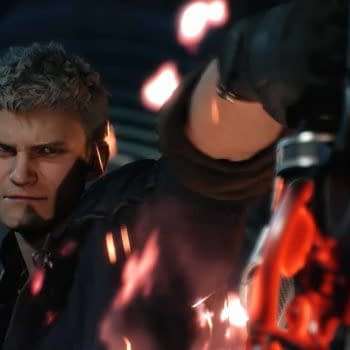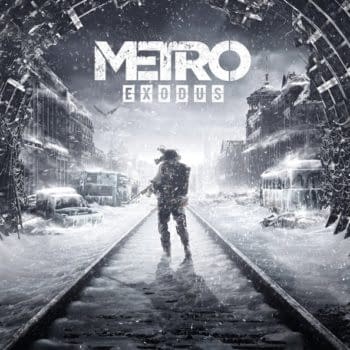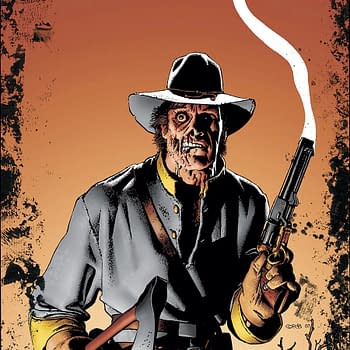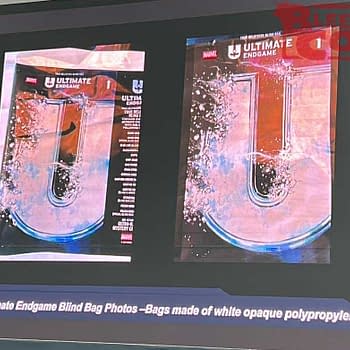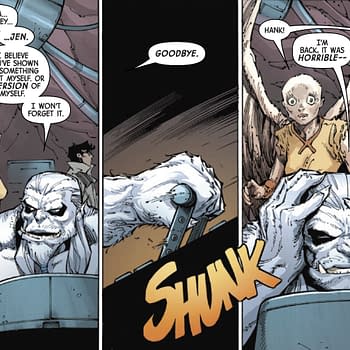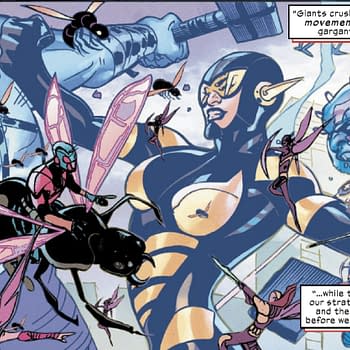Posted in: Comics | Tagged: 2000ad, bleeding cool, Comics, entertainment, lawless, phil winslade
Talking To Phil Winslade About 2000AD's Lawless, Using Real Pens And The Bayeaux tapestry
By Olly MacNamee
Phil Winslade has worked for 'em all at one time or another, making a splash with titles such as Goddess and Howard The Duck. With his recent welcome return to the pages of 2000AD, with his Lawless strip alongside Dan Abnett, there was no better time to catch up with Winslade and shoot the breeze.
Olly MacNamee: Phil, was becoming an artist always something you wanted to be? And if so, was it fine art of did you always dream of working in comics or some other similar commercial art field?
Phil Winslade: I have always been fascinated by the relationship of image and text and line and story. I was also fascinated by publishing and books. When I went to college on a foundation course I realised I wasn't cut out to be a "fine artist" as I came to the conclusion that most fine art I admired was a sort of commissioned commercial art and that modern art was more "show-business for the untalented". I think I always wanted to be relevant to normal people and am probably a bit of a Philistine – maybe it's where I come from but I believe personal expression and artistic drives can still be developed within a commercial framework, and you get to eat too.
That's why I was drawn to the comics I read as a child in the 70s – Barry Windsor Smith, Jack Kirby, Jim Starlin, Steve Gerber, Don McGregor, Steve Englehart and later John Wagner, Pat Mills, Howard Chaykin and Alan Moore. When I was about nine I started drawing my own comics and that continued in my spare time – especially at college until I made it a career.
I decided that what I disliked most about graphic design and illustration when I did my degree course was dealing with clients and the micromanagement involved which was basically to force you to imitate rather than innovate.
In the comics I was reading at the time there was a sense of creative talent relatively unchained and people with things to say being able to say them via the media.
OM: In recent memory you've drawn Jonah Hex and the Crime Syndicate for DC Comics as well as returning to the pages of 2000AD. That's quite some output for a man known to spend quality time on developing his work. Is this a case of several characters, or even genres, that you've been drawn to in recent times?
PW: I'm firstly attracted to the concepts and writing involved and what I hope it's trying to say but also from an artistic point of view new challenges and not getting stuck in a creative rut. My taste tends towards the quirky and left field which usually means the book gets cancelled fairly quickly or it's a short run in the US market. A couple of years ago I drew a strip called Threshold which was really the first time I'd drawn sci-fi and I really had a blast with it. The creative possibilities for fantastic imagery really excited me so I was very receptive to the project of Lawless which has not failed to deliver.
OM: Your work with Dan Abnett on the Judge Dredd Megazine strip Lawless is receiving a lot of positive feedback. How did your involvement with the series begin and how is it working with Dan?
PW: Well I met Dan a few years back at a Lille convention (though we'd crossed paths a few time professionally before) and I really admired his work. We exchanged phone numbers and that was that. Fast forward a few years and I'd been offered a project that had certain limitations and needed to get an opinion, so I saw Dan's number and phoned him as he has a much better understanding of the business than I do. We got chatting and he said that he and Matt Smith had been talking the day before about a new project and how I'd be the right artist for it. This fitted in with the other project quite well and so we got the ball rolling.
The thing that attracted me as well as working with Dan was that it was to be in black and white. I've always been attracted to the idea of "from my hand to your eye" – that direct communication. Maybe it's from my love of print – but I like the economy of it. In my comics I tried to build a world with the imagery that is cohesive and correct, relatively recognisable but at the same time an escape – much like I feel Kirby did. The idea that this is achieved in the most direct and elegant way with as few "filters" as possible has always been my ambition.
Colouring can always be a lottery in comics and if you're not working in a certain style you need very sympathetic colourists which is a difficult ask sometimes. Computer colouring can dominate the image, totally undermining what you're trying to do and for someone like me who uses fine lines a really light touch is needed but most editors want "everything louder than everything else" – especially in the States.
Then I read the first script and fell in LOVE with the characters; Dan has a way with characters that is second to none and the potential of the situation and the quirkiness of it was like coming home.
Dan and I have a highly collaborative relationship. We bounce ideas off each other and Dan is one of the most receptive and generous writers I've ever worked with.
OM: What is your art process; do you draw layouts, use lightboxes, ink digitally these days etc?
PW: I do thumbnails, layouts and then ink with real pens on a lightbox using copies of the layouts. The thumbnails are where I concern myself with storytelling and page layout. The layouts are really rough pencils (I find inking from finished pencils a hiding to nothing as you stand as much chance of losing something as enhancing and it's boring) which are for basic anatomy, expression, sometimes tonal balance, body language, general problem solving and blocking the space. Inking is still about drawing, textures, set building, detailing and tonal balance but I feel it's really important to have spontaneity in the pen stroke.
OM: If you'd lived in a different time do you think working on a newspaper comic strip might have appealed to you?
PW: Yes, but I doubt I'd have made the grade. I hugely admire the work of Alex Raymond (Rip Kirby), Jim Holdaway, Stan Drake, Frank Bellamy and John M. Burns. I like that comics were part of people's daily lives and that the strip form was used as an amusing distraction as well as tutorials on playing bridge, fishing or even cooking snook during World War Two. The narrative strip has been around since cave painting, even when I was at school at 8, I could see the relationship between a Marvel comic book and the Bayeaux tapestry. A wordless strip is as universal as music in its ability to convey and communicate a feeling, concept or story in any language. And all this can be achieved without a crew of cameramen, lighting engineers, special effects groups, producers or make-up artists. Anything that can be conceived or imagined can be conveyed "from my hand to your eye". That's really exciting.
OM: Have you ever been tempted to try your hand at writing?
PW: Yes but it's more difficult as an artist as editors like to see you in one box as a fixed commodity. I think I would need an editor who was willing to spend a lot of time helping me and most commercial editors simply don't have that time. It would also take a certain amount of trust from the comic company which might be unrealistic in the current environment. Plus, of course, my preference for left field and quirky and the obvious commercial drawbacks of such doesn't help.
OM: Which of your comics are you most proud of and why?
PW: I think proud might be the wrong word, as an artist you are always looking to surpass your previous work. My work with Steve Gerber (Nevada and Howard the Duck), with Archie and Garth (Goddess), with Jimmy and Justin (Monolith) and with Steve Pugh (Convergence: Harley Quinn) and what I'm doing on Lawless with Dan are certainly creative highlights for me.
OM: What next for you, Phil? More 2000AD or returning to Marvel or DC, and would you consider working for independent publishers?
PW: Hopefully Lawless will continue as I'm very keen to find out what happens in the lives of Lawson, Nerys, Kill-a-man et al in the coming years and want to be there drawing it.
Olly MacNamee teaches English and Media, for his sins, in a school somewhere in Birmingham. Some days, even he doesn't know where it is. Follow him on twitter @ollymacnamee or read about his exploits at olly.macnamee@blogspot.co.uk. Or don't.





